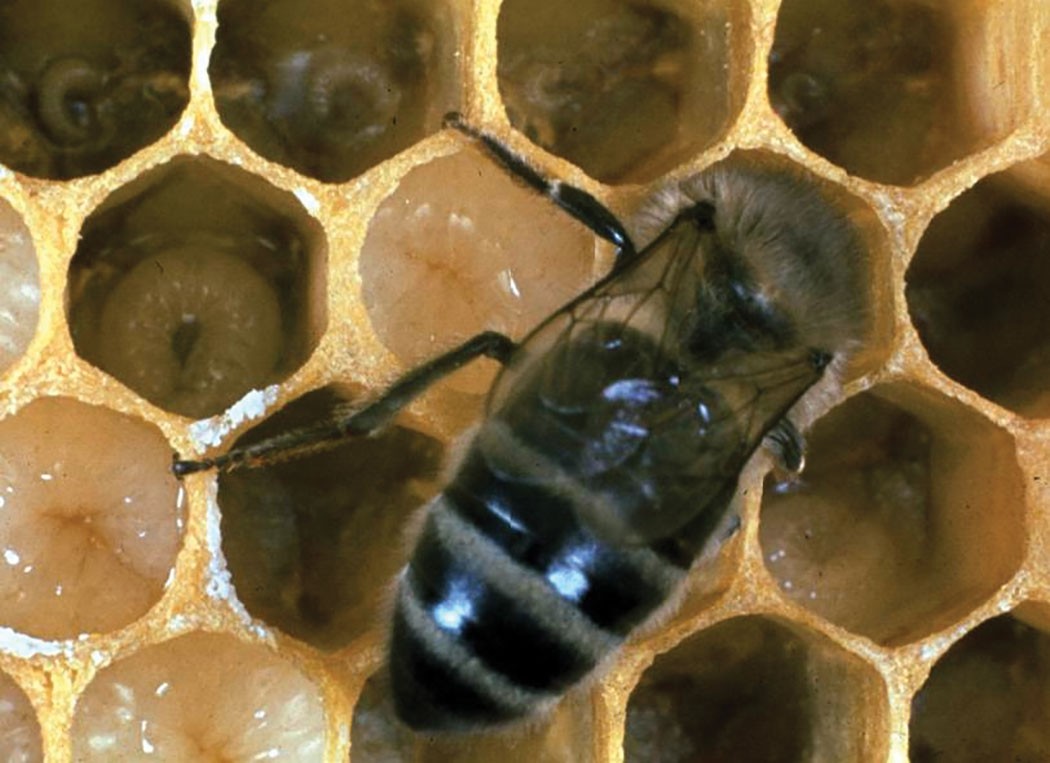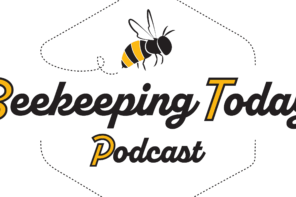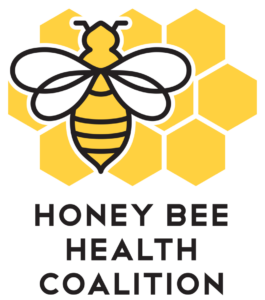Importance of Knowing Developmental Rates
by Larry Connor
Before obtaining the first bee colony, the future sustainable apiculturist must master key aspects of bee biology. Beekeepers must know the basic biological developmental rates of the three kinds of bees. It is not something that should be dismissed or ignored. Using the animal husbandry example, a beekeeper should know the developmental time of bees just like a cattle or dog breeder must know the developmental time and growth milestones of a calf or pup. Here are some common examples that I have seen happen with many new and less-experienced beekeepers:
There is no open brood. I think I lost my queen!
Events within the beehive take a set period of time, yet many beekeepers are in a big hurry for these things to happen and, as a result, ignore biology. If a European colony replaces a queen, it takes time for the new queen to develop, reach mating age, mate and then start laying eggs. Here’s a breakdown:
Queen development from egg to emerging……..16 days
Days to reach mating age…………………..7 days (or longer)
Days to mate……………………………..2 days (or longer)
Days to develop eggs after mating…………..3 days
TOTAL…………………………………..28 days
That is four weeks from future queen egg to her first worker egg! Some untrained beekeepers often expect to see new brood in two or three weeks as if Mother Nature will speed development just for them. Convinced the queen is gone, these beekeepers often buy another queen and really confuse both themselves and the bees by trying to introduce a queen to a colony that already has a queen in development! That is both wasteful and expensive, and it is poor animal husbandry.
My queen must be dead because I cannot see any eggs!
Bee eggs are small, and many beekeepers will carefully inspect a frame of brood on a dark day or without a bright light (the sun over the shoulder is best) and declare that the frame does not have any eggs or young larvae. When I take the frame and look, the frame is often filled with eggs and newly hatched larvae. Yes, the young larvae will appear nearly transparent, especially on light colored beeswax or plastic foundation. I often suggest these untrained folks get a flashlight and a hand lens to make these important inspections. While this is not really biology of the bee, it is about the biology of the beekeeper who cannot see. Schedule an eye exam!
I’ve had a queen in the hive for five weeks now, there is open and sealed brood in the frames, but the colony is losing bees. What is happening?
Many things can cause a colony to go into population decline, but five weeks is a critical time for bee populations if you let bees raise their own queen. If you add the 21 days it takes for new worker bees to grow from egg to emergence, you still have to add the time it took the queen to start laying, or 28 days.
Adding 21 and 28 days gives you seven weeks. It takes a long time for a colony to raise a new queen from the accidental death of the queen or when a beekeeper makes a walk-away split. Seven weeks is a very long time for a colony to be without emerging bees in the hive, especially if it did not have much sealed brood when it was originally set up or made queenless. Within three to five weeks you will notice that the population of adult bees is declining unless you intentionally selected or added frames of sealed and emerging brood specifically to boost the bee population.
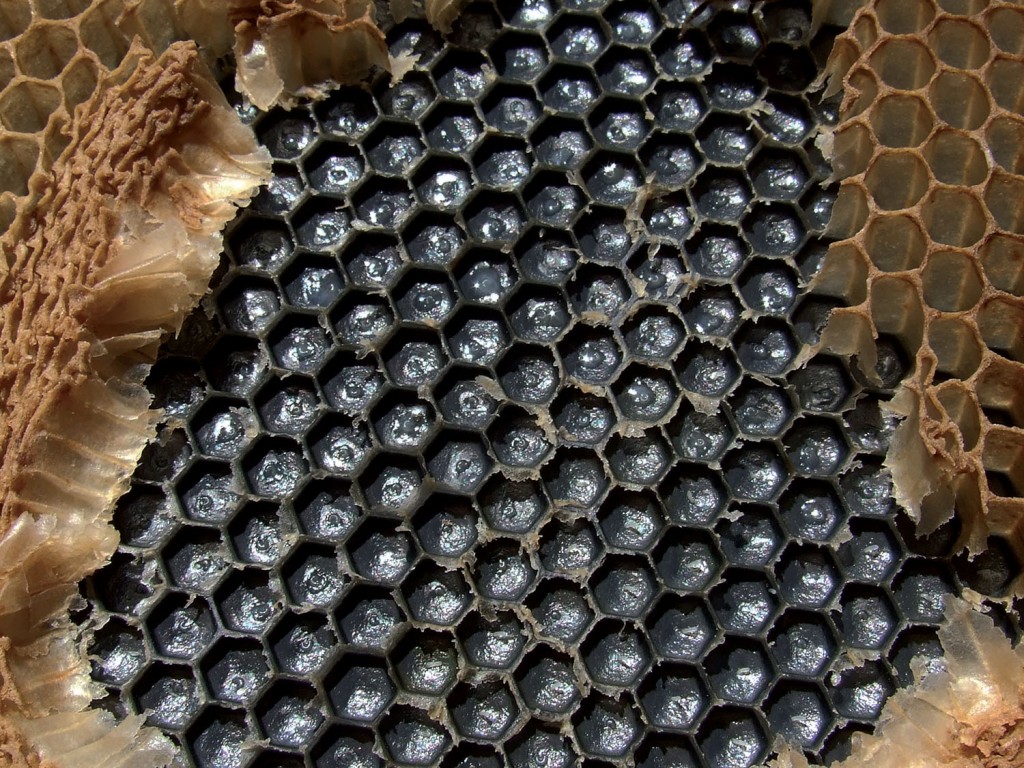
Why beekeepers do not see eggs and larvae. This is a black plastic frame of worker comb. Much of the new wax has been pulled off to reveal the eggs and larvae. The larvae floating on a bed of royal jelly are the ‘easiest’ to see. This is why beekeepers need to carry a flashlight and a hand lens in the apiary.
I keep bees in South Florida and I have trouble keeping the colonies from mating with Africanized bees. What can I do?
Researchers have shown that African queens develop about two days faster than European bees, while the hybrid Africanized bees develop one day faster than European queens. What does that mean to the beekeeper?
Because African queens emerge faster than European queens, your first concerns for producing queens in area with African genes is when you emerge queen cells in an incubator or cell finisher. Just one African queen cell will produce a virgin emerging a day or two early and the complete destruction of all the remaining cells. if you put queen cells you found on frames of brood into a new nucleus increase hive, you will find that the African queens will be preferentially favored.
Second, if you mate your queens in an area where both African and European drones are present, several studies have shown that the European queen is more likely to mate with European drones – they fly longer hours and are produced in larger numbers.
The beekeeper trying to mate queens in an area with African colonies need to develop a European-drone saturation program or develop an off-season mating program. Otherwise, they need to find an area that is free of the African bee and mate their queens to European drones at that location.
Here is a summary of the developmental time of the workers, drones and queens:
Workers
Most of the bees in a colony are workers. All worker bees are female but in a different caste than the queen. They do all the work in the hive and gather all the food (pollen and nectar) and water that the bees need to survive. Workers also collect resin from trees to coat the inside of the hive – we call this propolis. They are unable to mate with drones, the male bees and they do not attempt to make mating flights. They have very small reproductive structures and are only able to produce eggs in the absence of a queen bee’s pheromone. These eggs are unfertilized and will only become male bees.
Worker honey bees control the queen’s behavior and replacement as well as the number and age distribution of the drones in a hive. Unfertilized eggs are haploid, having just one set of chromosomes. In Hymenoptera (bees, wasps, ants), these develop into males. Worker-produced drones may or may not be significant in terms of passing on genetic information, depending on which scientist you ask. Is there a genetic benefit of the haploid-diploid sex determination system if a worker bee produces sons that contribute to the genetic composition of future colonies?
Worker Development
In whole days, the intervals of metamorphic honey bee worker development follow a mathematical progression: three days as an egg, six days as a larva and 12 days in the sealed cell. Remember this simple relationship: 3+6+12 equals 21 days. Like many things in the hive, these are averages, and the timing is not in exact 24-hour measurements. Temperature and nutrition apparently impact development rates.
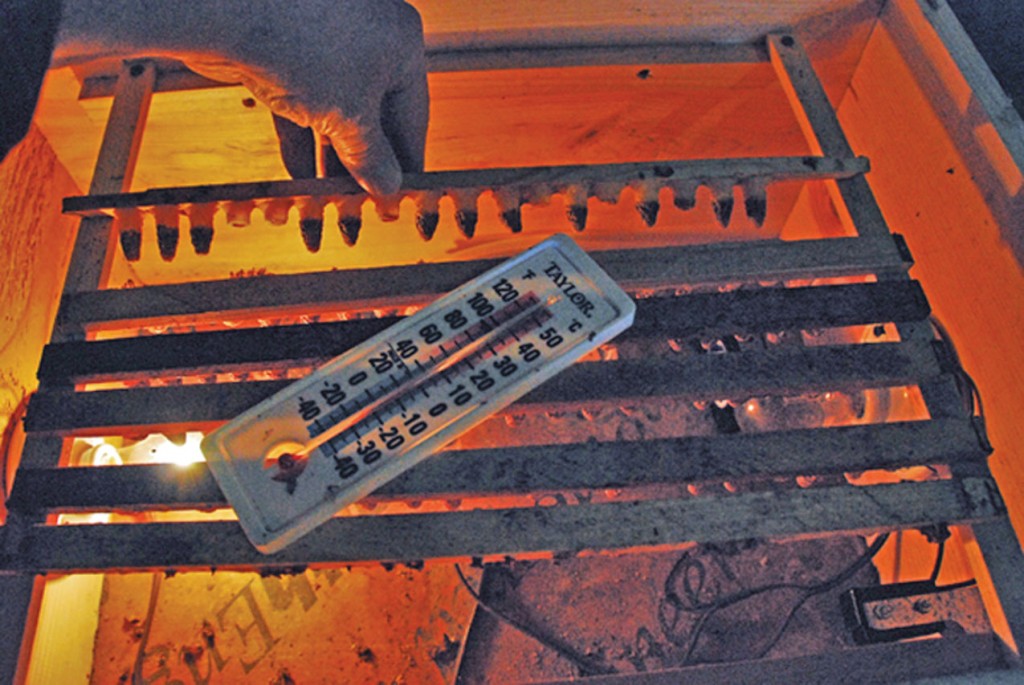
Queen cells in an incubator. Genetic differences in queen development time can produce an early emerging queen capable of destroying all these cells in a matter of hours.
The Egg
After first inserting her head into a cell to determine its size, the queen deposits one worker egg. As she positions her body into the cell, she releases some of the sperm stored in her spermatheca to accomplish fertilization. Queens may deposit both fertilized and unfertilized eggs, both workers and drones in worker cells, depending on the size of the cells. All worker eggs are fertilized, and a good queen will produce a pattern of 95% or more worker cells and a few missed cells where diploid drone eggs are deposited (they are removed soon after hatching). This is the time period for the union of the sperm and egg with the resulting embryo feeding on the yolk in the egg. There is rapid growth of the embryonic bee during this short three-day period. Eggs are held vertically, head down, by a small amount of cement at the bottom of the egg. At the end of three days, the outer egg shell, called the chorion, softens as it is reabsorbed into the body. The egg flattens onto the bottom of the cell and becomes the larva.
The Larva
Once the larva hatches, it immediately enters a period of continuous feeding and extremely rapid growth. In six days the bee grows from a tiny egg to a large larva. Nurse bees feed the larva many times per hour and provide a surplus of royal jelly at the bottom of the cell for the first 48-50 hours. This is the same food as fed to a queen bee larva throughout her larval period. After this initial feeding, the diet of the larva changes to a more complex diet that inhibits the formation of queen characteristics and promotes the formation of worker features. The special diet, called worker jelly, contains additional carbohydrates and lipid molecules that turn characteristics of worker development on and turn characteristics of the queen caste off. The worker larva floats on a bed of royal jelly.
When raising queen bees, this is the start of the perfect time to remove larvae and put her into a queen cup. The larva floats on the bed of royal jelly and molts at least four times before the final molt to become the pupa. The molting skin is extremely thin and hard to detect. During the sixth day, the bees place a beeswax ‘cap’ on the cell, even though the larva inside has not completed the larval developmental phase. At this time, the larval body changes into an intermediate prepupal form, which is intermediate between the larva and the pupal stage.
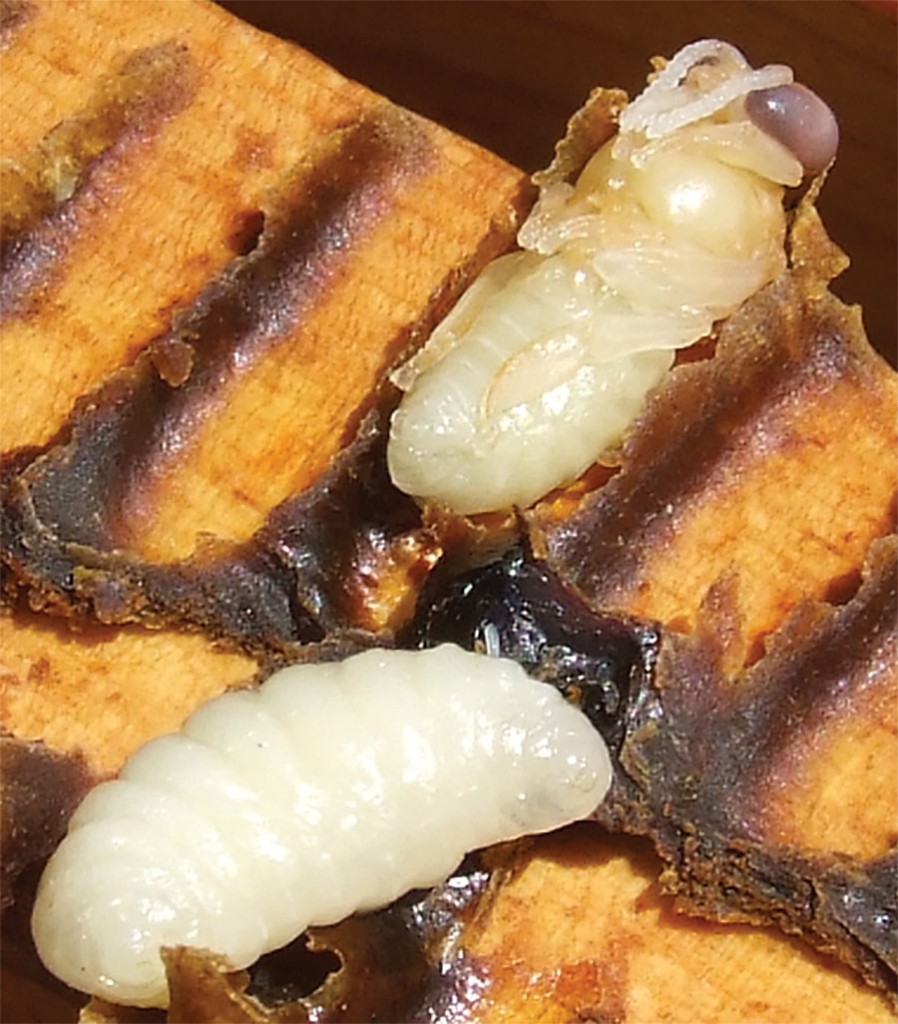
Bees pass through a four stage metamorphosis: egg, larva, pupae and adult. These two are the larva and pupae (with eyes darkening, the purple eye stage).
The Pupa
The larva spins a thin brown silk cocoon with special glands located in the head. Then, she molts the final time to become the pupa, with characteristics in the form of the bee but without wing development and integument pigmentation. The first parts of the bee’s external body to change color are the two compound eyes, first to pink and then to purple. Internally, the body is becoming more differentiated, with the formation of adult bee organs, like the honey stomach, developing out of the simpler larval digestive tract. Just how many changes take place during the ‘quiet’ or ‘resting’ phase of development is not known, but it is both large and essential to the adult bee’s many roles in the hive.
The Emerging Individual
Twenty-one days after the queen has deposited a tiny egg in the cell, the worker bee emerges, soft of body, unable to sting and covered with body hairs that have not yet dried in the atmosphere of the hive. Some refer to emergence as ‘hatching’, but we restrict the term hatching to refer to the egg-to-larval transformation, and the term ‘emergence’ for the worker bees cutting the the protective silk capping off her cell and walking, ready to begin her initial adult bee duties. These callow bees are responsive to the queen bee and quickly learn her odors which helps them in various parts of their adult life.
Differences in Developmental Rates
European races of honey bees follow a similar developmental pattern. When compared to African honey bees, the European queen and worker bee require additional time for development than the same castes in the African bees.
European vs. African Honey Bee Developmental Time from Egg to Adult
From Ellis, J., University of Florida and A. Ellis, Florida Dept. of Agriculture and Commercial Services. FDACS.DPI|EDIS. Accessed online 9 Aug. 2015.
European
Queen…16 days
Worker…21 days
Drone…24 days
African
Queen…14 days
Worker…19-20 days
Drone…24 days
Division of Labor
The Nurse Bee (In the Brood Nest)
These young bees quickly assume duties. No other bee provides instruction or hints at the job ahead. There is no mentoring or internship.
Cell cleaning – Newly emerged bees clean the cells of newly emerged cells; they remove remaining royal jelly, larval fecal materials and trim the capping of the cell. They also remove any lingering varroa mites still in development and destroy them. Once the cell is clean, I suspect they either remove any objectionable odor that might repel the queen, or they coat the empty cell with a special odor or pheromone that stimulates the queen bee to deposit a new egg into the cell, thus starting the brood production cycle all over again.
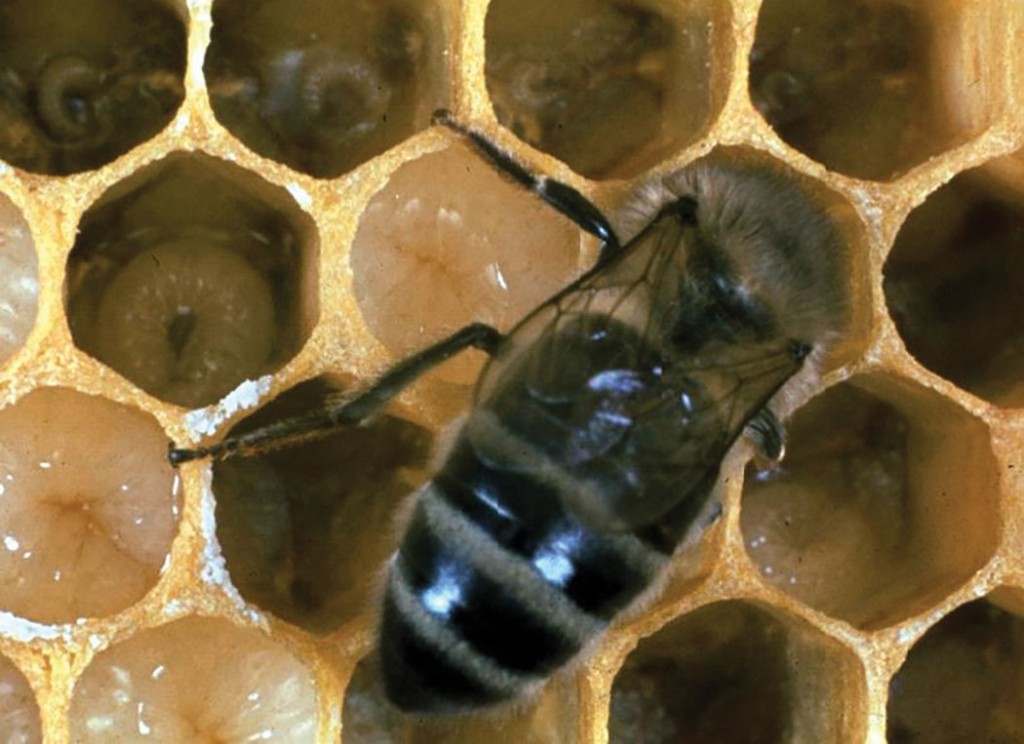
The developing brood is being fed by a nurse bee, a member of house bees that has not yet started to fly.
R. Williamson photo.
Feeding brood – Newly emerged bees quickly feed themselves pollen and nectar and are fed by other worker bees as part of the ‘community stomach’ of the hive, which includes food and chemical components collected from the queen. The feeding process stimulates the digestive tract of the bee to process the food and convert the proteins and carbohydrates into royal jelly. When beekeepers feed colonies of bees, only a small percentage of the bees collect food from the feeder device, but all the bees in the colony benefit from the feeding due to food-sharing behavior.
Royal jelly production – Each worker bee undergoes a period of abundant royal jelly production when the season and food supply allows. Most of the year this feeding is almost immediately after food intake, but in the Fall and early Winter, the royal jelly production is delayed as the colony takes a break in brood rearing. The appearance of the first larvae in January (in the northern hemisphere) stimulates royal jelly secretion by select nurse bees.
Brood regulators – It appears that these young bees determine the amount of royal jelly to produce, and, thus, the amount of brood to rear, based on stimulation by the increasing day length as well as the food budget of the hive. Here the ‘community stomach’ controls population growth. Bees with proper nutrients in their body cells and their digestive tract produce more royal jelly only when there is an abundance of food stored in both the combs and coming into the hive from foragers that find early season food. Quality food reserves in the body cells of over-wintering nurse bees are essential for the care and feeding of a healthy brood cycle early in the season. If in the prior season the colony had poor food reserves, it was exposed to parasitic mites and diseases, or the colony was undergoing any other stress, then the nurse bees are less fit for brood rearing. It is not the temperature outside the hive that determines the amount of brood that a colony produces, but the bee population and nutritional status of the nurse bees. This relationship makes these young bees critical to starting the new season properly.
Queen attendants – Nurse bees also feed and care for the queen. They regulate the amount of food she receives and they themselves are subject to complex factors that include the food reserves, the nutritional composition of the ‘community stomach’ and the population of young bees inside the hive. Part of this network is the feedback the nurse bees provide to the queen by returning modified queen substance to the queen – she then responds to her own chemical signals (pheromones and hormones). The queen retinue of attendants constantly changes. Look for queens with large retinues, at least ten and perhaps over a dozen worker bees, while resting. Queens with small retinues often do poorly in the hive.
Vist the Wicwas Press website at www.wicwas.com. And ‘like’ us on Facebook.







